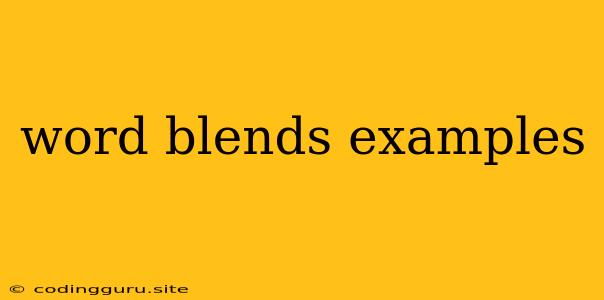What are Word Blends and Why Are They So Cool?
Have you ever heard of a word like "brunch" or "smog"? These aren't just random combinations of words, they're examples of word blends, a fascinating linguistic phenomenon.
Word blends, also known as portmanteau words, are created by merging two or more words together, taking parts of each to form a new word with a combined meaning. They're everywhere, from everyday language to popular culture and even scientific terminology.
But why do we create these blended words? What makes them so appealing?
Why Do We Create Word Blends?
Word blends are a testament to our creativity and need for concise, memorable language. They help us:
- Express new concepts: By combining familiar words, we can create new terms to describe emerging ideas or phenomena. For example, "smog" combines "smoke" and "fog" to describe the hazy atmospheric pollution.
- Conciseness: Word blends offer a way to shorten phrases and convey meaning more efficiently. Instead of saying "breakfast and lunch," we can simply say "brunch."
- Humor: Blending words often creates humorous effects, adding a playful twist to language. Think of words like "chillax," which blends "chill" and "relax," or "hangry," combining "hungry" and "angry."
Examples of Word Blends: A Colorful Mix
Word blends exist in various forms, and their creativity is as diverse as the words they combine. Here are some examples:
- Simple Combinations: "brunch" (breakfast + lunch), "motel" (motor + hotel), "smog" (smoke + fog)
- Creative Blends: "ginormous" (giant + enormous), "spork" (spoon + fork), "frenemy" (friend + enemy)
- Cultural Blends: "chillax" (chill + relax), "hangry" (hungry + angry), "blog" (web log)
- Technical Blends: "modem" (modulator + demodulator), "biotech" (biology + technology), "Wi-Fi" (wireless fidelity)
How to Create Your Own Word Blend
Want to unleash your inner linguist and create your own word blend? Here are some tips:
- Identify a concept or idea: What new word do you want to express?
- Brainstorm related words: Think about words that describe different aspects of your concept.
- Combine creatively: Experiment with different combinations of words and syllables.
- Test your creation: See if the blend sounds natural, conveys the intended meaning, and is easy to understand.
Word Blends: A Reflection of Our Times
Word blends are not just a linguistic curiosity; they offer a window into our evolving language and culture. As new ideas and concepts emerge, so do new words, often created through blending. This dynamic process reflects our need to adapt and express ourselves in a constantly changing world.
Conclusion
Word blends are fascinating linguistic creations that demonstrate our ability to innovate and communicate effectively. From everyday expressions to technical terms, these blended words add color and creativity to our language. So next time you encounter a new word like "shopaholic" or "staycation," remember the power and artistry of word blends!
